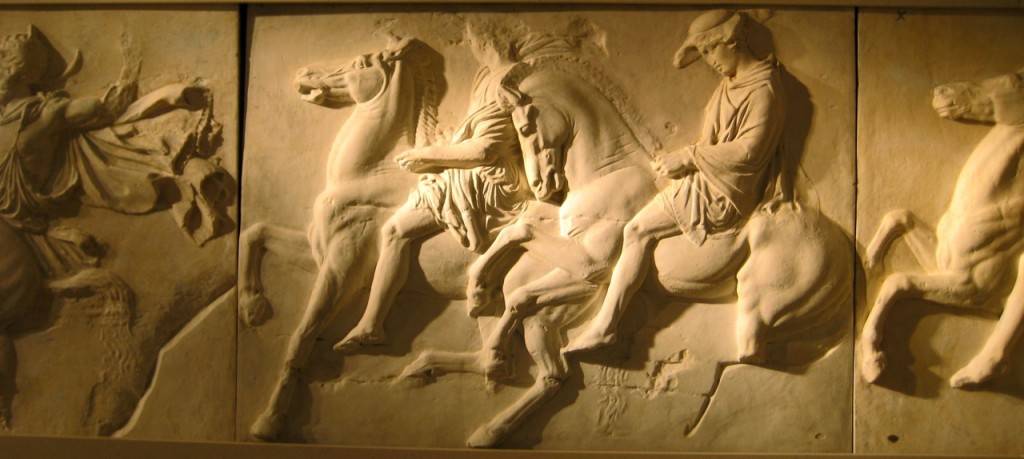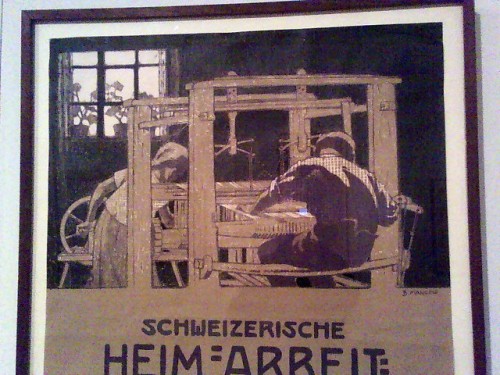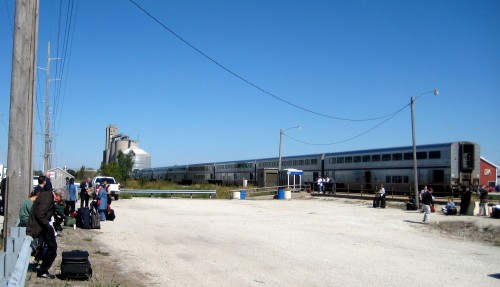I did not know there even was a National Postal Museum!
Tag: museums
The wonderful Spurlock Museum


A hundred-odd years ago, a lot of towns and cities had their own museum. In those days, international travel was beyond the reach of ordinary people, and museums saw it as part of their mission to bring the great artistic and cultural works of the world to a place where ordinary people could see them. To support that, a whole industry existed making molds of the great works of European sculpture, and then casting plaster replicas of those works to be displayed in museums.
After all, the Venus de Milo can only be in one museum, but should only people who can get to the Louvre be able to see it?
A few decades later, fashions changed. Air travel and other changes made it possible for ordinary people to get to Europe after all, so they could see the great works of European art and culture. Rather suddenly, it no longer seemed like a great service to show people copies of the greatest works of art and culture. Museums decided that they should show people originals—even if they could only afford 3rd rate originals.

Thanks entirely to great good fortune, at the time that this shift was at its peak, a budget crunch at the University of Illinois had virtually shut down the museums that are now known as the Spurlock Museum. They had so little money, they were unable to hire a director, meaning that there was no one in authority to throw out the plaster copies of the great works and replace them with 3rd rate originals.
At museums all over the country, an incredible number of these excellent copies—quite literally museum quality—were simply thrown away. But not those belonging to the Spurlock Museum.
Among other things, we have a fairly complete set of replicas of the Elgin Marbles, made from molds taken before an ill-fated attempt at cleaning did serious damage to the originals. Scholars come from all over the world to study our copies.

I was going to the Spurlock Museum today, to attend a meditation class by Mary Wolters (an excellent workshop, by the way), and decided to catch an earlier bus so I’d have half an hour to look around the collection. I’d several times wished I had a picture of one or another items from their collection to use to illustrate a Wise Bread post, and I figured this would be a good chance to get a few photos.
Having taken a few, I thought I’d share some here.

If you’re local, don’t miss the wonderful Spurlock Museum.
Brain chemicals and artist’s dates
In my family, “brain chemicals” is the shorthand term for unmotivated negative feelings. That is, when you’re feeling sad because something bad happened, that’s normal, but when you’re feeling sad for no particular reason, that’s brain chemicals. (On the theory that you’ve probably got a chemical imbalance or something, and that you should probably see a doctor about it when you’ve got the time.) The same applies to anger, frustration, anxiety, etc.
I mention this because I often suffer from brain chemicals, especially this time of year, when the days get short and dark and cold.
I’m actually doing pretty well this year. I’m doing a bunch of things that help. I’m taking my vitamin D. I’m trying to get outdoors for some actual sunlight, any day that there is any. I’m getting my exercise in. (For many months now, Jackie and I have been lifting weights three times a week and doing an hour of taiji three times a week. I’m trying to get in an hour of walking and at least a few minutes of additional taiji on the other days of the week.) I’m being productive. I’m getting enough sleep.
Still, despite all that, brain chemicals seemed to be setting in yesterday. I was feeling over-busy, under-accomplished, and frustrated. So, I went to level two in the fight against brain chemicals, and scheduled an artist’s date.
I think of it as a date with my muse. A proper artist’s date involves going somewhere and spending time with something that spurs creativity. That could be almost anything, and if I did them more often (and I really should) I’d probably have to broaden the range of places that I go. But I don’t do them very often, so I can usually get away with taking my muse to the same few places.
I started at the Krannert Art Center. Much of their exhibit space today was full of stuff that I had little interest in, but outside the museum proper there’s a changing exhibit of student work that’s often more interesting than the work in the museum itself. Today it had the work of school children. There were a lot of interesting ideas—for example, a low passageway made of cardboard where kids who’d studied ancient cave paintings had painted their own—even if only a few of the actual pieces spoke to me.
Connected to the museum is the school of design building. They often have some student work on display in the hallway, and I rather liked a small group of pieces by students who had apparently had the assignment to create a brand identity for themselves. They produced the same elements that a brand identity package from a marketing firm would provide—a name and logo (provided in a couple of sizes and formats, in both color and black & white), together with some key terms and images that could go into a branded ad campaign.
It was everything an artist’s date needs to be—a reminder that creativity is everywhere, a reminder that there can be joy in art of all sorts.
I was already feeling better today, and expect that I’ll feel even better tomorrow.
Feeding the soul
I was feeling kind of glum yesterday. It was just brain chemicals, I think—the result of a gray day when I was already feeling a little discouraged about my progress on my novel. (My recent post on how I’m not suffering as much from seasonal affect disorder notwithstanding.)
I was already feeling better today (it’s sunny), but decided to do something cheering anyway. So, I went to the Krannert Art Museum, which turned out to be showing an exhibit of turn-of-the-century poster art. I’m a big fan of poster art and art deco, so it was full of wonderful stuff. By merest coincidence, I’d earlier in the day happened upon this Art of the Poster 1880-1918 site, so I got a fun double dose of poster art.
Plus, one of the posters featured a loom, which I thought Jackie would appreciate.
There was also an exhibit of student art in the lobby outside the art museum that was much more interesting than 90% of what was in the museum itself. I couldn’t find a link, which is too bad. There was a lot of good stuff—some pretty, some funny, some thoughtful.
When it comes to dealing with glumness, I think it’s basic things that really matter—nutrition, exercise, getting enough sleep, spending some time out in the sun whenever there’s a sunny day. Once I’ve got that covered, though, the best short-term response to short-term glumness is to fit something cheerful into the day; preferably something that’s not just cheerful, but also meaningful in some way. For that, I particularly like going to museums. Something that’s merely cheering is worth doing. Something that’s cheering and also feeds the soul is even better.
Chicago trip, with sculpture
Jackie and I traveled by train to Chicago, going up Tuesday and returning Wednesday.
I like traveling by rail. It’s is more comfortable and more convenient than traveling by either car or plane, especially if you’re going to want to be downtown (where the train station is) anyway. So, as I’ve written before on Wise Bread, I’m a big fan of Amtrak. On the trip up, though, we did have a problem. Apparently, a freight train had derailed somewhere north of Gilman, leaving the track blocked.
Amtrak hired buses to take us from Gilman on into Chicago. Here’s a picture of where we waited for the buses to arrive:
The passengers who’d been faster getting off the train than us had already filled the first bus and departed, so here the rest of us are, waiting for the next bus. I’m not sure what train that is sitting there. The train we’d been on (the Saluki) had already departed, heading on back south to be ready for the next day’s trip to Chicago, I suppose.
The station itself is that bus shelter structure in the middle of the picture.
We got to Chicago about three hours later than planned, which rather messed up our schedule for the afternoon, but we had a nice trip anyway. Jackie and I went out for some brisk urban walking shortly after checking into our hotel. In Millennium Park, north of the Art Institute, we saw this:
Coming upon it produced the following conversation:
Me: What do you suppose it is?
Jackie: An amusement park ride?
Me: Maybe. Maybe it’s a solar power station.
Jackie: But it’s all shiny. That wouldn’t be very efficient.
Me: I bet I know! I bet it’s designed so that one day a year, when the sun is at a particular point in the sky, all those surfaces work together to concentrate the entire reflected power of the sun on one single point, vaporizing whoever happens to be standing there.
Jackie: That doesn’t make any sense. Think of the liability.
Me: You’re right. I guess amusement park ride is a better guess.
Today we took a bus down to Jackie’s old stomping ground in Hyde Park. We went to the Oriental Institute, the Seminary Co-Op bookstore, had lunch at Edwardo’s, and went to 57th Street Books, before heading back to Chicago and catching the Illini to come home.
A good trip, despite the unplanned bus ride from Gilman.
Eighteen Views Suffice
 View of Mt. Fuji, originally uploaded by bradipo.
View of Mt. Fuji, originally uploaded by bradipo.
Jackie and her mom and I went to the Indianapolis Museum of Art’s exhibit of Utagawa Hiroshige’s “36 views of Mt. Fuji.” This was part 2 of the exhibit, and featured 18 of the woodcuts.
I’ve always liked the Japanese woodcuts of this era, for much the same reason that I like poster art: I like the use of strong, simple images and the effective use of a limited color pallet. (I also rather like the particular shade of blue that they used.)
Besides the woodcuts, we also spent a chunk of time in an exhibit on drawings together with prints, etchings, and the like. Some were source drawings prepared for the engraver. Others were copies of etchings, drawn as studies. I find it interesting to think about the differences between poster art and woodcuts, versus etching, engravings, and so on—differences in intention, technology, result, etc.
We also walked a bit on the grounds. I particularly enjoyed the tow path along the canal behind the museum.
This was just our second visit to the museum, which is too bad—it’s a great museum. It’s more than 2 hours away, though, which makes for a rather long day. We enjoyed it enough that we’re thinking about getting a room in a hotel and making a 2-day trip of it. That would mean that we could spend a whole day (or two half-days) at the museum, instead of trying to cram everything into a few hours between two long drives.




